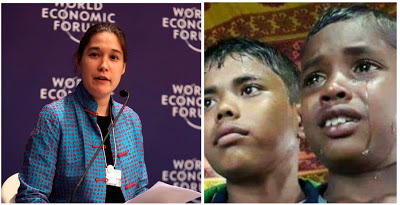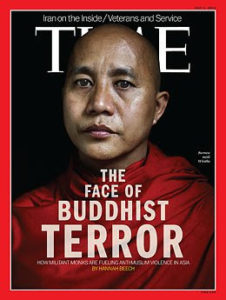Hannah Beech: “Journos’ Power without Moral Responsibility”
TRANSCEND MEMBERS, 5 Feb 2018
Maung Zarni – TRANSCEND Media Service
Hannah Beech’s select writings on Wirathu & Rohingyas have done lasting damage to Myanmar’s inter-communal relations and credibility of Rohingyas’ tales of horror while reinforcing Myanmar military’s popular misinformation against Rohingyas.
Re: “Rohingyas suffer real horrors – So why are some of their stories untrue” by Hannah Beech, New York Times, 1 Feb 2018
4 Feb 2018 – I am not exactly sure what the NYT reporter Hannah Beech’s intention is in weaving the story the way she did, with the ostensible goal of reminding the news industry of the need for journalistic skepticism.
Some of us know that her employer, the New York Times, or for that matter most US media outlets, has toed the Pentagon’s line on war and issues of certain American interests, throwing its “journalistic skepticism” to the wind. In the case of Bernie Sanders, the paper even twisted the message of certain important articles in order to damage Sanders’ campaign and advance Hilary Clinton’s election cheating within the Democratic Party rivalry.
While at TIME, Beech sensationalied the story of Wirathu by describing him as “THE FACE OF BUDDHIST TERROR” – without any quotation marks around “buddhist”. It comes as a surprise as she is self-admittedly a meditating Buddhist originally from Southern California who had a fine liberal art education at Colby College in Maine.
It had two types of major impact on the Burmese scenes and one major impact on the cross-national solidarity across anti-Muslim genocidal forces in South Asia and South East Asia.
First. Beech’s story turned the Buddhist majority against the foreign media because it sensationalized a then a minority phenomenon while letting the Incubator/Mobilizer of religious bigotry – the Myanmar Ministry of Defence and its proxy propaganda organs, in the “private media” – off the hook.
Second. her story boosted the political and personal significance of Wirathu, who was involved in burning alive the entire Muslim family, 90-miles south of my old town Mandalay.
Third. it was BEECH who, wittingly or not, built the global platform for Wirathu – who later became a subject another sensationalist French film screened at the Cannes.
I too toured the refugee camps in Cox’s Bazaar, Bangladesh myself and interviewed over 2 dozen women, men and children – in Burmese language, as well as through a Rohingya interpreter.
Surely, as interviewers one stays alert to any inconsistencies or possible embellishment.
But what is exactly Beech’s point of singling out a 9-year old kid who said he was a Rohingya from Myanmar where cricket is not played or popular, who fled the country, saying he “liked cricket”i,? I saw many a Bangladeshi children playing crickets on the beech of the Bay of Bengal, about half -hour drive from large refugee camps.
Many Bengladeshi children live within walking distance from the camps – in Bangladeshi villages along Tek Naf river and along the coast.
If her intention is to make sure that other media outlets separate facts from fictions then her intention is exceedingly self-conceited: some of the most accurate stories with depths on Rohingyas are written by freelancers on the margins who do real investigative journalism – not the mainstream corporate New York Times.
They too maintain necessary professional habit of journalistic skepticism.
In her attempts to reproduce this false view that the Great New York Times is the GOLD STANDARD in truth-production, she reproduces and reinforces the very genocidal military’s singular false narrative – a Rohingya man with 6 wives and 42 children.
This is an extremely lethal and popular narrative promoted in Burma officially by President’s men down to the local journalists.
So, Beech was not questioning the number of this grown-up Rohingya male – who may simply be boosting how great a man he was – as opposed to poking a hole at a 9-year child who may or may not even be a Rohingya child.
Then Beech recycles this vague and well-worn message that Muslims have been in Western Myanmar for generations while choosing not to point out the fact that Rohingyas were officially recognized as both citizens and an ethnic minority of Myanmar in the Encyclopedia of the Union of Burma as late as 1964.
Many a Bangladeshi apply for asylum in US, UK, etc. as “Rohingya”, a ‘commodified” identity in the asylum domain in Europe and N. America.
Was it possible that the kid picked up the tales of ‘cool’ cricket which he heard from other grown-ups in his family who have travelled back and forth between Arakan or Rakhine and Chittagong and Cox’sBazaar across the borders, while growing up?
I shudder to thiink what other profound and lasting impact that will have from Hannah Beech’s stories on my country’s already deeply troubled inter-communal relations – and cross-national rise of Islamophobia – perhaps well-intentioning but wholly misguided and intellectually incompetent.
I have a PhD from the University of Wisconsin at Madison, studied research methodologies at the universities of California, Washington and Wisconsin and conducted literally hundreds of interviews, with Burmese from all walks of life -ranking military officers, intelligence defectors, army deserters, refugees, dissidents, exiles, former political prisoners, politicians, armed resistance fighters, etc. Doctoral or academic research isn’t about shallow journalistic interviews typically under the pressure of fast-approaching deadlines. I have been a researcher for 30 years, though I identify myself as a human rights activist because that’s what is called for by the genocide, civil war and other heinous crimes my fellow Burmese peoples of all ethnic and religious backgrounds have been experiencing almost since the country’s independence in 1948.
This New York Times piece does NOT promote or signify “journalistic skepticism”. It damages the credibility of the tales which genocide survivors tell.
It is more than outrageous: it is a piece of yet another “I-am-a-better-journo-than-the-run-of-the-mill’ sort of grand standing waxed with a tinge of sensationalist warning to the industry.
If her additional message is that it is the humanitarian aid industry and to whom it responds fast and adequately – ala “the baby who cries louder gets the milk” – then that message gets buried under the pile of her subtext “Rohingyas are lying”.
I personally find it morally repugnant and professionally incompetent as a researcher who specialises in qualitative research, interviews and discourse analysis.
Voices from Inside the Rohingya Refugee Camps
______________________________________________
 A Buddhist humanist from Burma, Maung Zarni is a member of the TRANSCEND Network for Peace Development Environment, former Visiting Lecturer with Harvard Medical School, specializing in racism and violence in Burma and Sri Lanka, and Non-resident Scholar in Genocide Studies with Documentation Center – Cambodia. His analyses have appeared in leading newspapers including the New York Times, The Guardian and the Times. Among his academic publications on Rohingya genocide are The Slow-Burning Genocide of Myanmar’s Rohingyas (Pacific Rim Law and Policy Journal), An Evolution of Rohingya Persecution in Myanmar: From Strategic Embrace to Genocide, (Middle East Institute, American University), and Myanmar’s State-directed Persecution of Rohingyas and Other Muslims (Brown World Affairs Journal, forthcoming). He holds a PhD (U Wisconsin at Madison) and a MA (U California), and has held various teaching, research and visiting fellowships at the universities in Asia, Europe and USA including Oxford, LSE, UCL Institute of Education) , National-Louis, Malaya, and Brunei. He is the recipient of the “Cultivation of Harmony” award from the Parliament of the World’s Religions (2015).
A Buddhist humanist from Burma, Maung Zarni is a member of the TRANSCEND Network for Peace Development Environment, former Visiting Lecturer with Harvard Medical School, specializing in racism and violence in Burma and Sri Lanka, and Non-resident Scholar in Genocide Studies with Documentation Center – Cambodia. His analyses have appeared in leading newspapers including the New York Times, The Guardian and the Times. Among his academic publications on Rohingya genocide are The Slow-Burning Genocide of Myanmar’s Rohingyas (Pacific Rim Law and Policy Journal), An Evolution of Rohingya Persecution in Myanmar: From Strategic Embrace to Genocide, (Middle East Institute, American University), and Myanmar’s State-directed Persecution of Rohingyas and Other Muslims (Brown World Affairs Journal, forthcoming). He holds a PhD (U Wisconsin at Madison) and a MA (U California), and has held various teaching, research and visiting fellowships at the universities in Asia, Europe and USA including Oxford, LSE, UCL Institute of Education) , National-Louis, Malaya, and Brunei. He is the recipient of the “Cultivation of Harmony” award from the Parliament of the World’s Religions (2015).
Go to Original – maungzarni.net
DISCLAIMER: The statements, views and opinions expressed in pieces republished here are solely those of the authors and do not necessarily represent those of TMS. In accordance with title 17 U.S.C. section 107, this material is distributed without profit to those who have expressed a prior interest in receiving the included information for research and educational purposes. TMS has no affiliation whatsoever with the originator of this article nor is TMS endorsed or sponsored by the originator. “GO TO ORIGINAL” links are provided as a convenience to our readers and allow for verification of authenticity. However, as originating pages are often updated by their originating host sites, the versions posted may not match the versions our readers view when clicking the “GO TO ORIGINAL” links. This site contains copyrighted material the use of which has not always been specifically authorized by the copyright owner. We are making such material available in our efforts to advance understanding of environmental, political, human rights, economic, democracy, scientific, and social justice issues, etc. We believe this constitutes a ‘fair use’ of any such copyrighted material as provided for in section 107 of the US Copyright Law. In accordance with Title 17 U.S.C. Section 107, the material on this site is distributed without profit to those who have expressed a prior interest in receiving the included information for research and educational purposes. For more information go to: http://www.law.cornell.edu/uscode/17/107.shtml. If you wish to use copyrighted material from this site for purposes of your own that go beyond ‘fair use’, you must obtain permission from the copyright owner.

